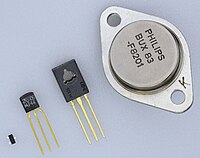
Photo from wikipedia
Multistate logic is recognized as a promising approach to increase the device density of microelectronics, but current approaches are offset by limited performance and large circuit complexity. We here demonstrate… Click to show full abstract
Multistate logic is recognized as a promising approach to increase the device density of microelectronics, but current approaches are offset by limited performance and large circuit complexity. We here demonstrate a route toward increased integration density that is enabled by a mechanically tunable device concept. Bi-anti-ambipolar transistors (bi-AATs) exhibit two distinct peaks in their transconductance and can be realized by a single 2D-material heterojunction-based solid-state device. Dynamic deformation of the device reveals the co-occurrence of two conduction pathways to be the origin of this previously unobserved behavior. Initially, carrier conduction proceeds through the junction edge, but illumination and application of strain can increase the recombination rate in the junction sufficiently to support an alternative carrier conduction path through the junction area. Optical characterization reveals a tunable emission pattern and increased optoelectronic responsivity that corroborates our model. Strain control permits the optimization of the conduction efficiency through both pathways and can be employed in quaternary inverters for future multilogic applications.
Journal Title: ACS nano
Year Published: 2021
Link to full text (if available)
Share on Social Media: Sign Up to like & get
recommendations!